Abstract
Purpose
The purpose was to review and appreciate data on structural sperm chromosome abnormalities obtained after fusion of human spermatozoa with zona-free hamster eggs.
Results
Breaks and fragments are the predominant sperm chromosome aberrations. In contrast to stable alterations, e.g., translocations, inversions, and deletions that will be transmitted unchanged into following cell generations, breaks, fragments, and some rearrangements have a reduced stability. In proliferating cell systems they will soon be eliminated through formation of lagging chromatin and micronuclei. Their relevance lies in a loss of genetic material or disturbance of cell division that may cause cell death. It is reasonable to assume a responsibility of such aberrations for early unrecognized conception loss. However, this interpretation is subject to criticism because an artifactual origin of sperm chromosome breakage cannot be ruled out.
Conclusions
The incidence and relevance of structural sperm chromosome abnormalities will remain at issue unless additional and complementary information is provided. For this purpose, new strategies must be developed because further studies employing hamster eggs according to existing protocols will not help resolve the dilemma.
Similar content being viewed by others
References
Rosenbusch B, Sterzik K: Cytogenetics of human spermatozoa. The frequency of various chromosome aberrations and their relationship to clinical and biological parameters. Arch Gynecol Obstet 1994;255:81–89
Benet J, Genescà A, Navarro J, Egozcue J, Templado C: Cytogenetic studies in motile sperm from normal men. Hum Genet 1992;89:176–180
Tarkowski AK: An air-drying method for chromosome preparations from mouse eggs. Cytogenetics 1966;5:394–400
Kamiguchi Y, Mikamo K: An improved, efficient method for analyzing human sperm chromosomes using zona-free hamster ova. Am J Hum Genet 1986;38:724–740
Martin RH: A detailed method for obtaining preparations of human sperm chromosomes. Cylogenet Cell Genet 1983;35:252–256
Brandriff B, Gordon L, Ashworth L, Watchmaker G, Carrano A, Wyrobek A: Chromosomal abnormalities in human sperm: Comparisons among four healthy men. Hum Genet 1984;66:193–201
Jenderny J, Röhrborn G: Chromosome analysis of human sperm. I. First results with a modified method. Hum Genet 1987;76:385–388
Benet J, Navarro J, Genescà A, Egozcue J, Templado C: Chromosome abnormalities in human spermatozoa after albumin or TEST-yolk capacitation. Hum Reprod 1991;6:369–375
Estop AM, Cieply K, Vankirk V, Munne S, Garver K: Cytogenetic studies in human sperm. Hum Genet 1991;84:447–451
Martin RH, Rademaker AW, Hildebrand K, Long-Simpson L, Peterson D, Yamamoto J: Variation in the frequency and type of sperm chromosomal abnormalities among normal men. Hum Genet 1987;77:108–114
Brandriff BF, Gordon LA, Moore II D, Carrano AV: An analysis of structural aberrations in human sperm chromosomes. Cytogenet Cell Genet 1988;47:29–36
Mikamo K, Kamiguchi Y, Tateno H: Spontaneous and in vitro radiation-induced chromosome aberrations in human spermatozoa: application of a new method.In Mutation and the Environment. Part B: Metabolism, Testing Methods, and Chromosomes, ML Mendelsohn, RJ Albertini (eds). New York, John Wiley, 1990, pp 447–456
Jenderny J, Jacobi ML, Rüger A, Röhrborn G: Chromosome aberrations in 450 sperm complements from eight controls and lack of increase after chemotherapy in two patients. Hum Genet 1992;90:151–154
Therman E, Susman M: Human Chromosomes. Structure, Behavior, and Effects, 3rd ed. New York/Berlin, Springer-Verlag, 1993
Ward WS, Coffey DS: DNA packaging and organization in mammalian spermatozoa: comparison with somatic cells. Biol Reprod 1991;44:569–574
Ward WS: Deoxyribonucleic acid loop domain tertiary structure in mammalian spermatozoa. Biol Reprod 1993;48:1193–1201
Brandriff BF, Gordon LA, Carrano AV: Cytogenetics of human sperm: Structural aberrations and DNA replication.In Mutation and the Environment, Part B: Metabolism, Testing Methods, and Chromosomes, ML Mendelsohn, RJ Albertini (eds). New York. John Wiley, 1990, pp 425–434
Cummins JM, Jequier AM: Treating male infertility needs more clinical andrology, not less. Hum Reprod 1994;9:1214–1219
Magenis RE: On the origin of chromosome anomaly. Am J Hum Genet 1988;42:529–533
Martin RH: Comparison of chromosomal abnormalities in hamster egg and human sperm pronuclei. Biol Reprod 1984;31:819–825
Kosower NS, Katayose H, Yanagimachi R: Thiol-disulfide status and acridine orange fluorescence of mammalian sperm nuclei. J Androl 1992;13:342–348
Jacobs PA: The chromosome complement of human gametes.In Oxford Reviews Of Reproductive Biology, Vol 14, SR Milligan (ed). Oxford, Oxford University Press, 1992, pp 47–72
Jonasson JA: Analysis and interpretation of human chromosome preparations.In Human Cytogenetics—A Practical Approach, DE Rooney, BH Czepulkowski (eds). Oxford, IRL Press, 1986, pp 85–134
Chernos JE, Rattner JB, Martin RH: An investigation of human sperm pronuclear chromosome “gaps” using scanning electron microscopy. Cytogenet Cell Genet 1986;42:57–61
Genescà A, Caballín MR, Miró R, Benet J, Germá JR, Egozcue J: Repair of human sperm chromosome aberrations in the hamster egg. Hum Genet 1992;89:181–186
Vogel F, Motulsky AG: Human Genetics-Problems and Approaches, 2nd ed. Berlin/Heidelberg/New York, Springer, 1986
Carrano AV, Minkler J, Piluso D: On the fate of stable chromosomal aberrations. Mutat Res 1975;30:153–156
Genescà A, Benet J, Caballín MR, Miró R, Germà JR, Egozcue J: Significance of structural chromosome aberrations in human sperm: Analysis of induced aberrations. Hum Genet 1990;85:495–499
Carrano AV, Heddle JA: The fate of chromosome aberrations. J Theor Biol 1973;38:289–304
Obe G, Beek B: The human leukocyte test system.In Chemical Mutagens. Principles and Methods for Their Detection, Vol. 7, FJ De Serres, A. Hollaender (eds). New York/London, Plenum Press, 1982, pp 337–400
Dean BJ, Danford N: Assays for the detection of chemicallyinduced chromosome damage in cultured mammalian cells.In Mutagenicity Testing—A Practical approach, S Venitt, JM Parry (eds). Oxford/Washington, IRL Press, 1984, pp 187–232
Pellestor F, Dufour M-C, Arnal F, Humeau C: Direct assessment of the rate of chromosomal abnormalities in grade IV human embryos produced by in-vitro fertilization procedure. Hum Reprod 1994;9:293–302
Angell RR, Templeton AA, Aitken RJ: Chromosome studies in human in vitro fertilization. Hum Genet 1986;72:333–339
Papadopoulos G, Templeton AA, Fisk N, Randall J: The frequency of chromosome anomalies in human preimplantation embryos after in-vitro fertilization. Hum Reprod 1989; 4:91–98
Jamieson ME, Coutts JRT, Connor JM: The chromosome constitution of human preimplantation embryos fertilized in vitro. Hum Reprod 1994;9:709–715
Plachot M, Veiga A, Montagut J, de Grouchy J, Calderon G, Lepretre S, Junca A-M, Santalo J, Carles E, Mandelbaum J, Barri P, Degoy J, Cohen J, Egozcue J, Sabatier JC, SalatBaroux J: Are clinical and biological IVF parameters correlated with chromosomal disorders in early life: a multicentric study. Hum Reprod 1988;3:627–635
Jacobs PA, Browne C, Gregson N, Joyce C, White H: Estimates of the frequency of chromosome abnormalities detectable in unselected newborns using moderate levels of banding. J Med Genet 1992;29:103–108
Chamberlin J, Magenis RE: Parental origin of de novo chromosome rearrangements. Hum Genet 1980;53:343–347
Olson SB, Magenis RE: Preferential paternal origin of de novo structural chromosome rearrangements.In The Cytogenetics of Mammalian Autosomal Rearrangements, A Daniel (ed). New York, Alan R. Liss, 1988, pp 583–599
Schinzel A: Phenotype in autosomal chromosome aberrations: Distinctiveness, variability, and karyotype correlations.In The Cytogenetics of Mammalian Autosomal Rearrangements, A Daniel (ed). New York, Alan R. Liss, 1988, pp 725–738
Gardner RJM, Sutherland GR: Chromosome Abnormalities and Genetic Counseling, Oxford Monographs on Medical Genetics No. 17. New York/Oxford, Oxford University Press, 1989
Chandley AC: The chromosomal basis of human infertility. Br Med Bull 1979;35:181–186
Bischoff FZ, Nguyen DD, Burt KJ, Shaffer LG: Estimates of aneuploidy using multicolor fluorescence in situ hybridization on human sperm. Cytogenet Cell Genet 1994;66:237–243
Liu J, Nagy Z, Joris H, Tournaye H, Devroey P, Van Steirteghem AC: Intracytoplasmic sperm injection does not require special treatment of the spermatozoa. Hum Reprod 1994;9:1127–1130
Rosenbusch B, Sterzik K: The cytogenetic constitution of spermatozoa obtained from subfertile men. Int J Fertil 1993;38:332–337
Brandriff BF, Gordon LA: Human sperm cytogenetics and the one-cell zygote.In Banbury Report 34: Biology of Mammalian Germ Cell Mutagenesis, JW Allen, BA Bridges, MF Lyon, MJ Moses, LB Russell (eds). Cold Spring Harbor, NY, Cold Spring Harbor Laboratory Press, 1990, pp 183–194
Creighton P, Houghton JA: Visualization of pig sperm chromosomes by in-vitro penetration of zona-free hamster ova. J Reprod Fertil 1987;80:619–622
Tateno H, Mikamo K: A chromosomal method to distinguish between X-and Y-bearing spermatozoa of the bull in zonafree hamster ova. J Reprod Fertil 1987;81:119–125
Hultén MA, Saadallah N, Wallace BMN, Creasy MR: Meiotic studies in man.In Human Cytogenetics—A Practical Approach, DE Rooney, BH Czepulkowski (eds). Oxford, IRL Press, 1986, pp 163–196
Lange R, Wilke G, Engel W: Analysis of meiotic chromosomes in ejaculates of infertile patients with an increased number of immature germ cells in semen samples. Andrologia 1992;24:249–253
Laurie DA, Firkett CL, Hultén MA: A direct cytogenetic technique for assessing the rate of first meiotic nondisjunction in the human male by the analysis of cells at metaphase II. Ann Hum Genet 1985;49:23–29
Sperling K, Kaden R: Meiotic studies of the ejaculated seminal fluid of humans with normal sperm count and oligospermia. Nature 1971;232:481
Pieters MHEC, Dumoulin JCM, Ignoul-Vanvuchelen RCM, Bras M, Evers JLH, Geraedts JPM: Triploidy after in vitro fertilization: Cytogenetic analysis of human zygotes and embryos. J Assist Reprod Genet 1992;9:68–76
Author information
Authors and Affiliations
Rights and permissions
About this article
Cite this article
Rosenbusch, B.E. Cytogenetics of human spermatozoa: What about the reproductive relevance of structural chromosome aberrations?. J Assist Reprod Genet 12, 375–383 (1995). https://doi.org/10.1007/BF02215729
Received:
Accepted:
Issue Date:
DOI: https://doi.org/10.1007/BF02215729




